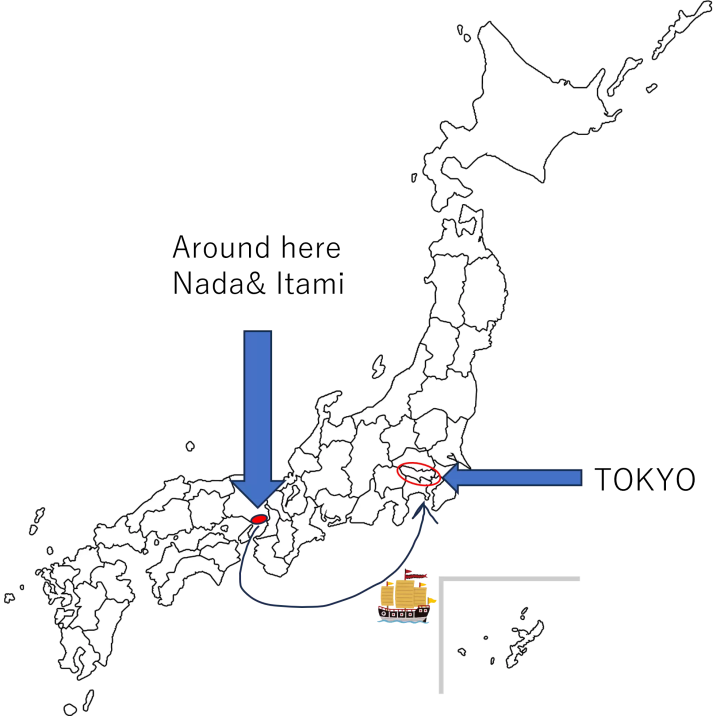The History of Sake

Sake is an alcoholic drink made using a method unique to Japan. The main ingredients are Japanese rice, rice malt, and water. Sake is also called "sake" or "rice wine" in English. This time, we will take a closer look at the history of sake.
-
Table of Contents
- Ancient Sake
- Around 700-800
- Edo period
- After 1800
- After 1990
Ancient Sake
It is said that the ancient method of making sake was to put raw rice in the mouth and spit it into a container, using enzymes in the saliva to break down the rice starch into sugar, which was then fermented by natural yeast in the air.
By the way, as the shrine maiden in the anime "Your Name" spits out, it is said that brewing sake was the job of shrine maidens.
Around 700-800
A method was developed to break down rice starch using koji mold. This is considered to be the origin of modern sake brewing. The koji mold used in Japanese sake brewing is characterized by the use of rice koji.
Edo period
During the Edo period, many people were able to drink sake. Around this time, distribution by ship began to take hold, and sake from Itami and Nada in Hyogo Prefecture began to be transported to Edo (present-day Tokyo). Sake from Itami and Nada became popular, and the two areas became the largest producers of sake.

Furthermore, technological development to produce sake of consistent quality progressed, and by the mid-Edo period (around the 18th century), sake brewing methods that were roughly the same as those used today were established.
After 1800
Once the manufacturing method has been established, research into rice and water will proceed, as will manufacturing facilities.
Sake was bottled for sale, and in terms of manufacturing facilities, it changed from storing sake in wooden barrels to enamel tanks... it was a gradual change from a wood-based lifestyle. The Liquor Tax Act had a big impact during the war, but we will talk about this separately. During and after the war, a lot of synthetic sake that imitated the flavor of Japanese sake was produced and consumed.
After 1990
The "Standards for Labeling the Quality of Sake Production Method" were applied, and it became mandatory to display the information on the label. This led to the widespread use of terms such as "specially named sake (such as junmai or ginjo sake)" and "ordinary sake." After that, sparkling sake and sake with a high alcohol content began to be sold, and various types of sake were produced. Vintage sake has also been attracting attention in recent years.
Check out Koshu no Ya in Awaji Island, Hyogo Prefecture now!
Takumi Sosei Co., Ltd. collects sake, shochu, plum wine, and awamori that have been aged for over 10 years from sake breweries across the country, and sells brands that have been carefully selected by wine sommeliers as delicious under the aged sake brand "Inishie no Bishu (Fine Wine of Ancient Times)". Even among Japanese people, few people know about sake that has been aged for over 10 years. Although it is not well known, it is also used in ceremonies of the Japanese Imperial Family. Takumi Sosei has two directly managed stores. ① Seigaiha Koshu no Ya 1st floor: We sell gift sets of aged sake tax-free. 2nd floor: You can enjoy dishes made with ingredients from Awaji and compare the taste of fine wine from ancient times. ② Koshu no Ya Omotesando store Gift set sales Please enjoy the world of aged sake made in Japan.
The contents on this page may partially contain automatic translation.































![[Kanazawa] Enjoy the world of gold leaf to the fullest in the city with the highest production volume in Japan](https://resources.matcha-jp.com/resize/720x2000/2025/11/12-249564.webp)
![[2026] Family Winter Trip to Suzuka Circuit! – For Both Day trips and Overnight Stays!](https://resources.matcha-jp.com/resize/720x2000/2025/12/26-254097.webp)
![[Northern Okinawa] 4 Recommended Cosmos Fields in Okinawa | Sunflowers and Cherry Blossoms in the Same Season!](https://resources.matcha-jp.com/resize/720x2000/2024/08/12-192028.webp)

